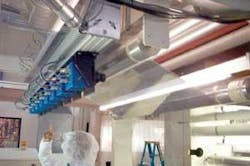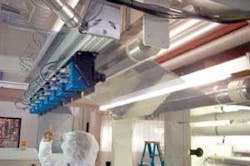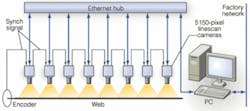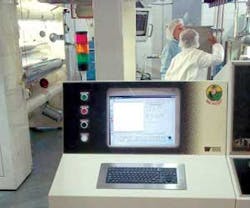Cameras streamline web inspection
Defects in specialty film are located and archived by custom inspection system.
By C. G. Masi, Contributing Editor
Bekaert Specialty Films produces light-absorbing films for tinting windows for both automotive and architectural applications. These transparent plastic films are a fraction of a millimeter thick and are designed to bond to a glass substrate. Since people look through them, they have to be completely free of visible defects. For this application, the size threshold is approximately five- to ten-thousandths of an inch (mils), so the defects are approximately 100 μm across on a web that is 72 in. wide moving at 200 ft/min.
Defects include pinholes, scratches, tears, and inclusions, but the most difficult defects to spot are gel spots-regions of the film where an error in the polymerization process changes the film’s optical properties. These spots have the same thickness and transparency, but variation in one of the optical properties changes the way light moves through the film. The most common gel-spot mechanism changes the material’s refractive index. This causes light rays to be deflected slightly instead of going straight through the film. The resulting effect is subtle, but quite visible. The difficulty is in knowing how to detect it.
With scratches, pinholes, and inclusions, all you have to do is look for places where the optical density changes rapidly. A pinhole, for example, lets light through the hole, while an inclusion blocks light. A gel spot, however, appears as a spot where the film’s transparency varies much more slowly. There might be a slight, gradual darkening in a wide band around the spot, with the center appearing slightly lighter.
The variations have a relatively low spatial frequency and relatively low amplitude-making it difficult for an image processor to pick up, although the human eye can spot it quickly. Bakaert called on Wintriss Engineering to build a web-inspection system, using its gel-spot identification algorithm, which is based on in-camera blob analysis, to pick up these defects.
Two-Pronged Solution
Wintriss’ approach to solving the web-inspection problem involves combining smart cameras, lighting, and Ethernet network protocol (see “Linear illumination,” p. 31). Smart-camera technology allows the collection and processing of large amounts of image data at the system’s front end, reducing the amount of information that passes downstream through the system. Ethernet makes it possible to combine information derived from several such cameras (eight in Bekaert’s case) into one comprehensive picture of the web (see Fig. 1).
For web inspection, linescan cameras are more efficient than area-scan cameras because they capture a single line of a raster pattern at a time. As the web moves through the field of view (FOV), the camera picks out one line at a time. If the width of a pixel line is, say, 10 mils, then a web speed of 200 ft/min translates into approximately 4000 lines/s.
Each scan line becomes a raster line in an image of effectively unlimited length-exactly what you want to represent a roll of window-tinting film. If you tried to do the same thing with an area-scan camera (which has pixel dimensions set by the optical system), you would have to match the frame rate to the web speed so that you could stitch tens of thousands of frames together into a long record. A linescan camera, on the other hand, can automatically make the adjustment. A shaft encoder measuring the web speed automatically adjusts the line rate and pixel dimension in the web-travel direction to compensate for any web-speed variation.
Custom Smart Camera
While linescan cameras are the clear choice for web inspection, smart linescan cameras are relatively rare. Wintriss was faced with no source for an appropriate camera, so the company designed and built its own camera and optimized it for web inspection. The OPSIS ALC camera has a proprietary linescan sensor that feeds image data to a digital image-analysis processor implemented in a 300,000-gate EP2S30F672 Stratix FPGA manufactured by Altera Corporation (see Fig. 2). This DSP performs all of the processing to initially locate and identify defects in real time using Wintriss algorithms. The result is a reduced data stream identifying locations and classifications of defects in the strip of web passing through that camera’s FOV.
This information then goes to a MPC860 PowerPC microprocessor from Freescale Semiconductor. The processor packages the information and passes it over the Ethernet to a host PC. It also provides a means of reprogramming the FPGA.
“This is the sixth or seventh camera that we’ve designed,” reports Vic Wintriss, president of Wintriss Engineering. “With earlier cameras, you had to program all the registers and program all the bits of the sensor. We could do it, but our customers couldn’t, and it was even quite difficult for us. We finally got smart and put a real-time operating system, [Wind River] VxWorks, on the PowerPC in the camera.”
With VxWorks, Wintriss can write high-level programs in C, which makes calls to VxWorks utilities, which, in turn, perform the low-level functions. Combined with the flexibility of an FPGA, this software system makes programming-or reprogramming-the smart camera much easier. It is even easy for third-party resellers. “We sell cameras to OEMs who put in their own value-added software,” Wintriss reports.
Wintriss uses multiple linescan cameras across the web to provide full-width coverage at whatever resolution is needed. The 72-in. Bakaert web uses eight Opsis 7500ALC cameras. Each camera captures a line of 7500 pixels, making 60,000 pixels across the web. Each pixel is 1.2 mils wide, which offers enough resolution to spot defects a few mils across (see Fig. 3).
Ethernet Glue
Each camera reports defects it finds in the portion of the web it monitors. The host PC then combines that data into an overall map of defects throughout the web (see Fig. 4).
While many defects lie within one camera’s FOV, some occur at the edges overlapping from one camera view strip to the next (such as long streaks not aligned with the web direction) or may even span more than one strip. The host computer must note these overlaps and resolve them into a seamless picture spanning the web.
The host serves as the system’s data server, archiving web inspection results for all rolls of material produced on a given line. These take the form of defect maps from which engineers and managers can derive additional useful information. For example, process managers can find and cut out excessively defect-ridden sections of the web and sell the remainder in smaller rolls; managers can monitor process health by automatically reporting statistics derived from analysis of multiple defect maps; and defect maps can even help resolve disputes with customers over product quality.
The combination of smart linescan cameras and Ethernet data communication produces a robust, flexible, easy to work with web inspection system. Data communication over Ethernet allows distributing the machine intelligence where it will do the most good. Putting fast image-analysis capability up front as DSP hardware implemented in FPGAs built into the linescan cameras makes tying the system together via Ethernet feasible. Finally, installing the VX Works operating system makes the system user-friendly.
Linear illumination
Providing high-quality backlighting is critical for inspecting Bekaert’s window-tinting film-production web. Conventional lighting via fluorescent or incandescent sources can’t provide the stable, even illumination needed to reach Bekaert’s quality goals. To provide the necessary lighting, Wintriss Engineering built an optically diffused LED array, which provides 100,000-hour life expectancy.
The source is a linear array of white LEDs as long as the web is wide. To homogenize and shape the output beam, Wintriss used a cylindrical lens, which collimates the light in the web-motion direction and spreads it transversally. The result is a uniform beam of rays parallel to the horizontal plane, yet moving randomly within it. A calibration algorithm built into the digital-signal image processors of the cameras adjusts each pixel’s gain to account for variations in space and time.
C.G.M.
Company Info
Altera
San Jose, CA, USA
www.altera.com
Bekaert Specialty Films
San Diego, CA, USA
www.bekaert.com
Freescale Semiconductor
Austin, TX, USA
www.freescale.com
Wind River
Alameda, CA, USA
www.windriver.com
Wintriss Engineering
San Diego, CA, USA
www.weco.com




